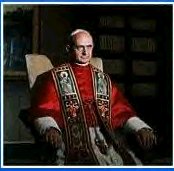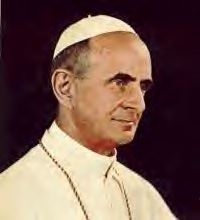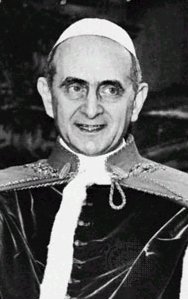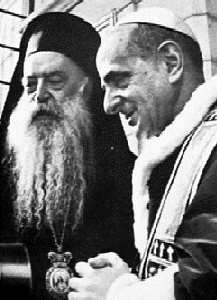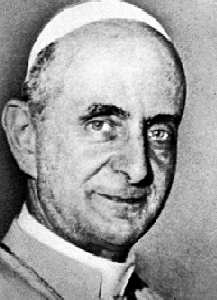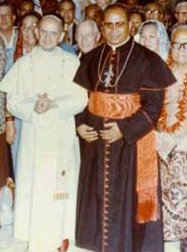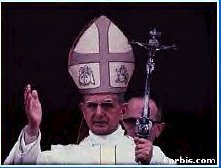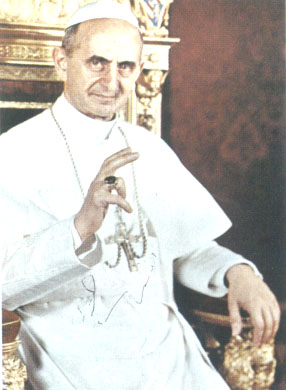
Pope John Paul II
Born: May 18, 1920
When Pope John Paul died in September 1978, just 34 days into his reign, Wojtyla was among the candidates to succeed him. The Sacred College of Cardinals chose him on the eighth round of balloting, on October 16, 1978. Aged 58 at the time, he was the youngest pope in 132 years.
Karol Josef Wojtyl became Pope John Paul II on October 16, 1978. The first Polish Pope, John Paul II has acted to maintain a the distinct characteristics of the Roman Catholic Church by resisting changes in church policy and maintaining discipline. He has also acted as a statesman urging peaceful solutiuons to world crises. He is the most traveled pope, visiting 50 countries on 6 continents.
There have been two assassination attempts against Pope John Paul II. In the first, he was shot by Mehmet Ali Agca in St. Peter's Square on May 13, 1981. The second attempt, in 1982, did not injure him.
Over the last 10 years, John Paul II has suffered a number of serious
health problems. He had a colon tumour removed in 1992, and broke his femur
two years later. Now, in addition to Parkinson’s disease, he has an
arthritic right knee. Because public appearances have become increasingly
arduous, he recently curtailed his usual participation in Holy Week and Easter
ceremonies.
Frail pope struggles through Holy Week services
By CANDICE HUGHES
Associated Press Writer
VATICAN CITY -- A frail Pope John Paul II struggled through Holy Thursday ceremonies in St. Peter's Basilica, twice ceding his place at the ornate main altar to other clerics.
It was the second time in less than a week that John Paul has let someone take his place in a major Holy Week ceremony.
The pontiff, who will be 82 years old in May and suffers from symptoms of Parkinson's, had a tough schedule Thursday, a Mass in the morning and another one in late afternoon.
Twice he was wheeled down the long main aisle of St. Peter's, standing on his special cart. And twice, someone else took his place at the altar.
John Paul read his homily and recited or chanted several prayers at each service seated in a white throne with golden arms and wearing heavy gold-trimmed vestments.
During the afternoon ceremony, John Paul let Cardinal Angelo Sodano and Cardinal Roger Etchegaray perform the ritual washing and kissing of the feet of priests, a ritual symbolizing humility, the first time he has not done so since becoming pope in 1978.
Just a year ago, the pope was able to move down a line of a dozen seated, white-robed priests, pouring water on each man's right foot from a golden pitcher, wiping them dry and bringing the feet to his lips.
The New Testament says Jesus washed the feet of his 12 disciples when they ate one last meal together on the day before he was crucified.
During the morning Mass, at which priests renew their vows, Cardinal Dario Castrillon Hoyos took the pontiff's place at the main altar.
Just four days earlier, in another break with his traditions, John Paul ceded his place at the altar for Palm Sunday Mass. The ceremony opens Holy Week, the most important stretch on the Church calendar.
Holy Week is a grueling time for John Paul, with a packed schedule of public appearances. He is scheduled to perform a Good Friday service at the Colosseum, a vigil service on Saturday night and an Easter Mass in St. Peter's Square on Sunday.
The Good Friday procession, which symbolizes Jesus' path to his crucifixion, has been modified in deference to John Paul's age and health. He used to carry a wooden cross for the entire half-mile procession, but stopped last year.
Symptoms of Parkinson's were evident Thursday. The pope's hands trembled badly as he clasped them, and his speech was often slurred. He also seemed unsure of his balance, gripping the rail of his cart when raising his hand in blessing.
The Vatican hasn't mentioned the pope's health during Holy Week, but said Feb. 23 that he had a joint disease, arthrosis, in one of his knees. He has since canceled a number of public appearances.
Thursday's ceremonies, which centered on priests and their vows, were especially poignant because of the sex abuse scandals rocking the church in the United States and elsewhere.
John Paul broke his silence on the scandals last week, saying they had cast a ''dark shadow of suspicion'' on other, honorable priests.
On Thursday morning, he invited prayers for ''our brothers who didn't meet their commitments that came with priestly ordination or who are going through a period of difficulty and crisis.'' While thanking God for the gift of the priesthood, John Paul said, ''we cannot help but confess our infidelities.''
Thursday morning Mass had just ended when the latest high-level resignation came -- that of the archbishop of Poznan in John Paul's native Poland over allegations he had made sexual advances on young clerics.
Without comment, the Vatican said the pope had accepted the resignation of Archbishop Juliusz Paetz, his appointee and longtime acquaintance, and named a successor.
Report: Pope will not retire
By NICOLE WINFIELD
Associated Press
VATICAN CITY - The Vatican specialist who collaborated with Pope John Paul II on the best-selling book "Crossing the Threshold of Hope" says the pontiff has firmly decided not to retire.
In a front-page article Saturday in the Milan daily Corriere della Sera, Vittorio Messori quoted what he said he had deduced from the pope's thoughts on the subject:
"The force to continue is not my problem but that of Christ, who wanted to call me, though unworthy, to be his vicar on Earth. In His mysterious design, He has brought me here. And it will be He who decides my fate."
Messori did not say how he had made the deductions or how he had learned what the pope thought. He said, however, that his information on the subject was recent and without doubt.
The pope himself referred indirectly to the issue Saturday in a homily marking the feast day of St. Peter and Paul.
"Like them, we are invited to follow an itinerary of conversion and love with Christ," the pontiff said. "Isn't it He who has called us? Isn't it always He who we must announce with consistency and fidelity?"
A Vatican spokesman, the Rev. Ciro Benedettini, said the Vatican had no specific comment on the Corriere report but added it was not particularly new. Even before Saturday, the pope has on various occasions said it was for God to decide when his work was finished, Rev. Benedettini said.
The article, however, was published as new questions arose about the pope's health and rumors circulated he might use a trip to his native Poland in mid-August to announce his retirement.
John Paul turned 82 in May and has appeared increasingly frail in the last several months, suffering from the symptoms of Parkinson's disease as well as hip and knee ailments.
He has cut back on participation in long, ceremonial Masses and uses a chariot-like cart to get around when he does celebrate them. His speech is slurred, often to the point of incomprehension and he frequently appears out of breath.
As his 82nd birthday approached, questions about his future heightened, with a leading cardinal and possible successor, Oscar Rodriguez Maradiaga of Honduras, saying he thought John Paul "would have the courage" to resign if poor health left him unable to carry out his ministry.
The Vatican immediately dismissed such suggestions - as it has in the past when they have surfaced - and John Paul himself that same week asked for prayers and support to continue his ministry.
Vatican officials have said whatever his physical limitations, the pontiff's mind is still sharp.
And the pope continues to travel: He has a three-nation trip planned starting July 23 - his 97th foreign visit - to preside over the Roman Catholic Church's World Youth Day celebrations in Toronto. He is then to travel onto Mexico and Guatemala.
Vatican spokesman Joaquin Navarro-Valls had suggested, while the pope was in Bulgaria last month, that the pontiff might drop the stops in Guatemala and Mexico for health reasons.
However, the Vatican later announced that the trips would go ahead as planned.
There is no provision in church law for removing an incapacitated pope, but it does allow popes to resign.
There is precedent - Pope Celestine V, who abdicated in 1294. He spent the last two years of his life in confinement because his successor feared he could become the rallying point for a schism.
Pope John Paul II in Canada.
No one could have failed to have been moved — first to shock, perhaps pity, then to admiration — by the sight of the frail and stooped Pope John Paul II descending under his own power from the papal plane in Toronto yesterday. On his previous pilgrimage, he had to be taken off the aircraft by an elevator device, the 82-year-old pontiff being too weak to walk. But arriving in Canada, John Paul showed himself stronger than he has been in months (at least in public), and in his welcoming remarks, spoke with a much clearer and firmer voice than he has used of late. The pontiff's flesh is weak, but the spirit is clearly willing — and sometimes it conquers.
Well, he has always said that he was going to keep going till the very last. Is this foolish? Maybe. No one could begrudge the great man, who has just embarked on his 97th pilgrimage abroad, a well-deserved rest. Admittedly, it's a sad day when the barest performance minimum ("He's walking! He's talking!") is seen as an unexpected triumph. Nevertheless, the Roman Catholic Church's supreme pastor is giving the last full measure of devotion to his Church and his calling, turning himself into a living icon representing the virtue of suffering for the sake of others. Whatever one's criticism of his pontificate, it is impossible not to be moved by his enduring sense of mission.
Why does he do it? I once spent an hour standing ten feet from him in a Jerusalem courtyard, as he waited in an SUV to leave for the airport. I studied his face, especially his hooded, fathomless eyes. He seemed as old as the world, lost in a mystical cloud of prayer and contemplation. Or maybe he was just tired. Nevertheless, in that moment I thought of Dostoevsky's holy monk Elder Zosima, about whom Alexei Karamazov said, "He is a saint, and his heart knows the secret of regeneration for all, the power that will finally establish the rule of truth on earth." I choose to think that's why he carries on, despite it all.
If the glory days of this papacy have faded into a troubled twilight, so, it seems, has World Youth Day. There are dramatically fewer young people to greet the pope in Toronto than there have been in 18 previous World Youth Days. Organizers expect the numbers of youth pilgrims not to exceed 200,000 — still the size of a small city, but half a million less than was predicted two years ago, when Toronto was chosen as the site for this year's event.
The sex-abuse scandal in the American branch of the Church may have something to do with the depressed numbers (still, more than one out of every four registered participants comes from the United States). There are several more likely explanations, however, offered by World Youth Day officials and others.
For one, holding the event in Canada has proven problematic. The Catholic Church there, like most Canadian churches, has been in steep decline, and the government is aggressively secular. The Canadian bishops are weak and ineffectual, and the Catholic Church itself has been weakened by its own child sex-abuse scandals in years past. Canada has a relatively small population spread out across a continent, making the ratio of host-country participants small. And, the Canadian government, citing immigration concerns, denied an unusual number of visa requests.
Furthermore, WYD officials reportedly discouraged youth under 16 from coming, in an attempt to return the annual event to its original vision, which was to be a meeting for older teenagers and young adults. Younger Catholics swamped the 1993 WYD in Denver, boosting its attendance numbers considerably.
Given the precarious state of the pope's health, there was no way to guarantee that John Paul would be present at the event, which surely kept a number of pilgrims who might otherwise have gone from spending the money for the trip.
Finally, there's no getting around the effect of September 11. Given the world situation, would you be willing to send your children to another country, one where Islamic radicals are known to be active, to attend a large, explicitly Christian public event that would present a near-irresistible target for Muslim terrorists?
Along those lines, it has to be counted a loss to American Catholics, and to America itself, that John Paul did not schedule a visit to Ground Zero in New York as part of this North American pilgrimage, which will take him to Mexico and Guatemala as well. There was speculation last fall that the pontiff would stop at the disaster site to pray, but Vatican officials insist that was never considered.
"There were some people in New York who hoped that he would come simply to visit or pray at the World Trade Center, but there's no way he can just skip in and skip out," the Jesuit father Thomas J. Reese told the Associated Press. "If he comes to New York, he has to meet with the president, meet the governor, go to the United Nations, and lead a big mass."
Really? President Bush, Governor Pataki, and Mayor Bloomberg could have arranged to meet him there, pray with him, and even allow the pontiff to celebrate an onsite mass for the families of the dead, if the pope so chose. No one would have expected the frail pontiff to undertake a full schedule in New York.
The missed opportunity for evangelical witness almost breaks one's heart. The sight of this brave and tireless successor of St. Peter, standing once again at a site of one of history's most notorious mass murders and prophetically preaching the gospel of life to a world hell-bent for death, would have been breathtaking the world over. It is hard to believe that John Paul, the old actor who has always shown a profound appreciation for the power of theatricality, didn't understand this.
John Paul need not have said much about the scandal had he come here, but anything he would have said, no matter how brief, indicating that he knows how much faithful American Catholics are suffering these days-especially the youth who have suffered directly — and encouraging them to remain steadfast in the faith, would have been like balm in Gilead.
Well, however disappointing for us Americans, that may be expecting too much from a man who has already given more than anyone can reasonably have expected from him. His surprising liveliness upon arriving in Canada surely has something to do with the well-known fact that John Paul loves young people, and draws strength from their presence. Watching televised images of that dear old soul reaching out with trembling hands to draw an adoring 10-year-old girl in for a kiss on the cheek (she had said to him, "I love you"), I thought of old Zosima again, saying to his followers, "I shall not die before enjoying one more talk with you, my dear ones, before once more looking at your dear faces and once more pouring out my soul to you."
by Rod Dreher
of the National Review
http://www.nationalreview.com/dreher/dreher072402.asp
By Larry Witham
THE WASHINGTON TIMES
A frail Pope John Paul II today arrives in Toronto for World Youth Day, the start of an 11-day tour that will fly over the United States to Guatemala and Mexico for local saints' canonization ceremonies.
Three saints will be canonized in Guatemala City and Mexico City at the end of the tour, which marks John Paul's 97th foreign journey. All told, he has elevated 462 persons to sainthood since 1978.
The dramatic trip will highlight — as at past youth events in Colorado and Italy — the vitality of church youth, but it will also showcase the pope's failing health and the shadow of the priest sex-abuse scandal in the American church.
Archbishop Anthony G. Meagher, president of World Youth Day, said the pope's trip shows "the providence of God" after two traumas: the terrorism of September 11 and the "public shame" of the scandal.
Vatican officials say the pope has no plans to cross into U.S. territory 30 miles away to comment on the scandal. "I go to pray with them, be joyful and have together with them an enriching experience of faith," the pope said before his trip.
John Paul, 82, who once bounded from airplanes to kiss the earth, now trembles from Parkinson's and cannot walk unassisted. Often, others must complete the reading of his messages.
Still, he has galvanized Toronto with the largest public event in the city's history despite lower turnout than expected.
"What started off at a slow pace has picked up tremendously in the past two months," the Rev. Peter Fleming of St. Joseph's Church in Toronto said in a telephone interview yesterday. "Young people are very resilient and enthusiastic and good at mingling."
He said this youthful chemistry can anchor the faith and morals of the church in young people for a lifetime — and do it with an international flair.
His church, for example, will host 225 young "pilgrims" from France and West Africa for the six days of outdoor music, devotions, prayers and a Mass and vigil with John Paul on Sunday.
But the scandals have undermined some high estimates of the turnout and the terrorism put Canadian authorities on alert for visa problems.
Canada's Department of Citizenship and Immigration has denied visas to 6,000 foreign registrants, even though it has waived the $50 application fee and added staff to cope with the volume of applications.
To avoid an influx of people from poor countries, the visa process required that applicants "show they qualify, that they're a genuine visitor, and not seeking a permanent move," an official said.
In Boston over the weekend, Voice of the Faithful, a U.S. group that formed over the abuse crisis, held a protest rally of 4,000 and said the pope should address the topic on North American soil.
"I don't believe that the scope of the crisis in the United States has been conveyed to the pope, or he would slip over the border and say something about this," spokesman Mike Emerton said yesterday.
A group of Catholics from Quebec who have charged sexual abuse by church leaders said they will show up to demonstrate in Toronto, where the pope once visited briefly in 1984.
According to reports, Vatican officials say a papal schedule is hard to alter and that America should not demand all the attention, since it holds just 60 million of the 1 billion world Catholics.
(Copied
from a cache copy of the article. The original was already pulled off the
internet)
FROM: http://www.detnews.com/2002/religion/0207/30/a04-543049.htm
July 26, 2002
Leaders worry ailing pontiff will leave church in crisis.
By Richard Boudreaux / Los Angeles Times
Gregorio Borgia / Associated Press
Pope John Paul II blesses the faithful during Sunday's Angelus prayer in his summer home in Castelgandolfo, southeast of Rome.
VATICAN CITY -- In plain sight of a global audience, Pope John Paul II has endured an assassin's bullets, a broken hip, four operations, an arthritic knee, the ravages of old age and the debilitating, immobilizing symptoms of Parkinson's disease.
Now, as he prepares for a trip this week to the Americas, the most public of pontiffs is beset by an indignity no predecessor has had to face: increasingly open debate in the Vatican and the Roman Catholic Church over whether he should quit because of ill health.
The worry is not so much that he will suddenly die, but rather that he will become senile or be left in a coma, throwing the church into a leadership crisis. Under Catholic canon law, a pope may resign but cannot be retired against his will, even if he is mentally unfit to rule.
Concern has grown in the last 10 months as Parkinson's, a neurological disorder first diagnosed in John Paul a decade ago, began to steal the pope's already quavering voice. John Paul, 82, often looks like a spectator to his own pontificate, sitting passively as aides read homilies that he starts but cannot finish.
No one in the Vatican has dared to call publicly for the pope's abdication.
But German Cardinal Joseph Ratzinger broke a taboo in May, telling reporters he believed the pope would resign if his condition got so bad that he felt incapable of carrying on in his job. Ratzinger, the Vatican's top theologian, is one of the pope's most powerful aides, and his remarks were echoed by a leading Latin American cardinal, Oscar Rodriguez Maradiaga of Honduras.
John Paul, who trembles badly despite medication and who can no longer walk unassisted, has replied emphatically that he has no intention of stepping down. No pope has done so since 1294. On Tuesday, he begins a 10-day journey to Canada, Guatemala and Mexico -- his latest display of will to soldier on.
"I feel every day that my ministry is sustained by the incessant prayer of the people of God, of so many people ... who offer their prayers for the pope," the pontiff said in June. "In moments of great difficulty and suffering, this spiritual strength is an immense help and an intimate consolation."
Vatican spokesman Joaquin Navarro-Valls acknowledges that the pope "is operating under limitations that are visible to all" but insists that John Paul's memory, sense of humor and ability to plan "are all intact."
Frank Bruni The New York Times Monday, July 29, 2002
FROM: http://www.iht.com/articles/65999.html
TORONTO It was once very different. Pope John Paul II, who traversed the globe with a frequency and zest unlike any of his predecessors, would pack in three or four major events on each day of a foreign trip. His smiles would be constant, and his speeches would go on and on, ambitious in their scope and unwavering in their delivery.
But this week, during the pope's first visit to North America in more than three years, he spent more time in seclusion than in public view, and his rare, painstakingly choreographed appearances - which averaged only one a day - showed why.
Movement was an effort. Words were a struggle. What Americans observed more immediately than ever before was a pope so physically diminished that the church officials watching him grew excited over the smallest glimmers of vigor: an assisted walk down the stairs of his plane, a few syllables enunciated with more volume than others, a fleeting grin on several occasions when applause washed over him.
"You have the idea," said the pope's spokesman, Joaquin Navarro-Valls, "that what you see there is a soul leading a body - a soul pulling a body."
It has now reached the point where that image - inspiring to some observers, discomfiting to others - largely defines John Paul II's papacy and overshadows other aspects.
He slowly lifts his right hand to his brow, and the people watching him worry: Is it a gesture of pain? Or is he merely trying to prop up his head and keep his face upright?
He ends a speech with a spontaneous sentence that does not make clear sense, as he did Thursday night, and his listeners wonder: Is he simply falling prey to the kind of flub that bedevils many an orator, or is it something more?
For some Catholics, the overarching question is whether the 82-year-old pope remains fit enough to handle the challenges that confront him, including the rash of reports of child sexual abuse by priests that have outraged worshipers in a number of countries.
"I admire his courage and his determination, but I think it might be better for all concerned if he stepped down," said the Reverend Andrew Greeley, a prominent Catholic sociologist and writer in the United States.
"You can't be as vigorous as a pope needs to be right now when you're hung up with arthritis and Parkinson's disease and the remnants of an assassination attempt," Greeley said.
The child sexual abuse problem has received especially intense scrutiny in the United States, plunging the American church into what some prominent Catholics call one of its greatest crises. But the pope, just a few dozen miles from the U.S. border for the last five days, is scheduled to fly over the country Monday on his way to Guatemala and then Mexico for canonization ceremonies.
The United States was never part of his plans for this trip, which centered on the Roman Catholic Church's World Youth Day, a weeklong religious jubilee that was held in Toronto this year.
Vatican officials and experts said that the United States was not included on the pope's itinerary for many reasons, including a lingering belief at the Holy See that the dimensions of the sexual abuse problem have been exaggerated.
But they said that the pope's health was also a consideration, shaping and limiting much of what he does or does not do these days.
That was certainly true in Toronto, where he spent most of his first four days at a church retreat on an island north of the city. Activities on his schedule that might once have been open to reporters, like a meeting Saturday with Prime Minister Jean Chretien, were not.
His one public appearance was at a prayer vigil Saturday night with an enormous audience of adoring Catholics, to whom he described the Sept. 11 destruction of the World Trade Center as "an image that is a sort of icon of a world in which hostility and hatred seem to prevail."
In Rome, too, the routines have changed. According to Vatican officials, he often receives foreign bishops in groups of five, instead of seeing them one-on-one as he did in the past. And he often forgoes his previous practice of reading a speech to them, instead distributing written copies. But people who have spent time with the pope say that for all his physical difficulties, he remains mentally acute.
Cardinal Oscar Rodriguez Maradiaga of Honduras, who is often mentioned as a possible successor, said Friday that the pope "is showing how you can fulfill a mission to the very end, with courage and with love."
So he presses on - despite knees that do not carry him well, despite the damage done two decades ago by a would-be assassin's bullet. In August, he is scheduled to visit his native Poland. Vatican officials have even floated the possibility of a trip in January to the Philippines. It would be a long, arduous journey. But, said Navarro-Valls, "He wants to go."
Abuse is source of 'shame'
The pope said Sunday that sexual abuse of children by priests was a source of shame and sadness to Catholics, and asked church members to rally behind the "vast majority" of virtuous clerics, Reuters reported from Toronto.
The comments, which the pope made during an outdoor Mass to about 800,000 young Roman Catholics, were believed to be his first in public since the damaging scandal broke in January, although he has addressed the issue in documents and in meetings with church leaders.
"The harm done by some priests and religious to the young and vulnerable fills us all with a deep sense of sadness and shame," the pope said during a Mass that concluded World Youth Day.
He spoke as news emerged that two New Jersey priests had been arrested in Montreal earlier this month on charges they solicited homosexual sex from minors. Canadian newspapers reported the two were found during a police operation to break up a child prostitution ring. On Monday he leaves for Guatemala and then Mexico
Pope's long trek comes to an end
2 martyred Indians beatified before pontiff leaves for home
FROM: http://www.chron.com/cs/CDA/story.hts/world/1518710
By RICHARD VARA
Copyright 2002 Houston Chronicle Religion Editor
MEXICO CITY -- Pope John Paul II bade an emotional adios to Mexico on Thursday after honoring two Indians martyred 300 years ago.
"As the popular song says, 'Me voy, pero no me voy,' " the pope told a crowd of 10,000 at the Basilica of the Virgin of Guadalupe. "I'm going, but I'm not going. I am leaving, but my heart remains."
Shouts of "¡Que se quede!" or "Stay!" echoed through the basilica before a band began to play Las Golondrinas, a popular farewell song.
The fervent scene culminated a two-hour service in which the pope beatified Juan Bautista and Jacinto de los Angeles to the rousing cheers of Indians from Oaxaca, the home state of the martyrs. Beatification is the last step before possible sainthood in the Roman Catholic Church.
Thursday's Mass continued the theme of Indian equality that John Paul began preaching Tuesday in Guatemala and repeated Wednesday during the canonization of Juan Diego Cuauhtlatoatzin, Mexico's first Indian saint. But instead of an audience dominated by government leaders and people in suits, at least one-third of Thursday's predominantly working-class crowd were indigenous people from across the country: Mazatecos, Maya, Mixtecos, Tecuates, Treques and Zapotecans in native attire.
Tenor Ramon Vargas and an orchestra gave way Thursday to a Oaxacan banda de viento playing music popular in the region.
Seven Indian languages were spoken in the beatification service, which was filled with Indian symbolism. The Gospel was read in Zapotecan, the language of the two martyrs.
Bautista and de los Angeles were killed by a mob of Zapotecans who were upset that the pair had denounced them to church authorities for pagan worship.
The two men were acting as fiscales, laymen who were church caretakers and evangelists. In September 1700, they learned a rite of idolatry would take place. The ceremony was raided that night, and the next day angry villagers seized the two men and beat them with clubs. "Their chests were cut open and their hearts were taken out and given to the dogs," according to a Vatican biography.
John Paul, who wore an embroidered Indian stole, described the martyrs as "humble and simple men" who "gave their lives to defend the faith with the power of the Holy Spirit."
"As they were being tortured, they were invited to renounce their Catholic faith and save themselves," the pope said in his homily. "But they answered bravely: `Once we have professed baptism, we shall always follow the true religion.' "
When the pope declared the duo as "blessed," or beatified, the basilica erupted in cheers. Nine Mazatecans with large plumed headdresses performed the Dance of the Feathers, their leaps and strides matching the colorful performance of the Aztec dancers at the canonization of St. Juan Diego.
Indian women bearing smoking pots of incense brushed branches of herbs on the pontiff, Cardinal Norberto Rivera Carrera and other prelates in a limpia ceremony. The common Indian blessing is believed to cure spiritual and physical ailments.
John Paul, who appeared energized by the festive crowd, said Bautista and de los Angeles should "motivate the Indians of today to appreciate their cultures and languages, above all, their dignity as sons of God that others should respect within the context of the Mexican nation."
The Rev. Emilio Alonso Antonio, a priest and Zapotecan from Oaxaca, said he and his group of 50 arrived at 2 a.m. for the basilica services both days.
"We are the same nation as the martyrs," Antonio said. "For us as Christians, it is a blessing that some from our community reach the altars (to be venerated).
"This is an opportunity for Indians to realize the dignity of our personhood," Antonio said. "This will help the relations between the government and the Indian communities. In general, it will help Mexican society to value the indigenous."
Fellow Zapotecan Victoria Rassado Sanchez, attired in Indian dress and wearing ribbons in her braids, said the canonization and beatification of the three Indians would provide a greater focus on the indigenous of Mexico.
Rassado said the pope moved her to tears when he said he was departing but leaving his heart behind. "The condition in which we see him is that he is tired, and the truth is that we will not see him again," she said.
The frail 82-year-old pope did not make a final speech at Mexico City's airport before leaving for Rome. As John Paul's plane taxied toward the runway, Mexican President Vicente Fox summed up the pontiff's visit for a national television audience.
"This visit leaves us with commitments to work together for the poor, for those left behind, for those excluded from development," Fox told the largely well-heeled crowd who had gathered at the airport's presidential terminal to see the pope off. "It also left us with a renewed commitment to the indigenous communities."
"Now," Fox said, "back to work."
The emotion of the day was heightened by the realization that John Paul's fifth visit to Mexico could be his last. His daily routes from the apostolic nunciature to the basilica attracted millions of people hoping to catch a glimpse of their revered holy father in his popemobile.
Tens of thousands stood four and five deep along the avenue near the papal ambassador's house Thursday morning.
Many had arrived before sunrise to be in place for the pope's 9:30 a.m. departure for the basilica. As the hour approached, latecomers rushed down a blocked-off avenue to get in place. Men in suits and women in high heels ran awkwardly for blocks, some giggling with excitement.
John Paul's three-day visit to Mexico followed an overnight stop in Guatemala, where he canonized Central America's first saint, and six days in Canada, where he attended World Youth Day festivities.
In Canada, he spoke publicly for the first time about the sexual abuse scandal involving U.S. priests, calling the crimes and misdeeds of some priests a source of "shame" and urging young Catholics not to lose faith.
Although plagued by Parkinson's disease and arthritis and at times needing help to stand, the most-traveled pontiff in history won't rest long when he returns to Italy. He is scheduled to visit his native Poland later this month.
Mexico City Bureau Chief Dudley Althaus contributed to this story.
